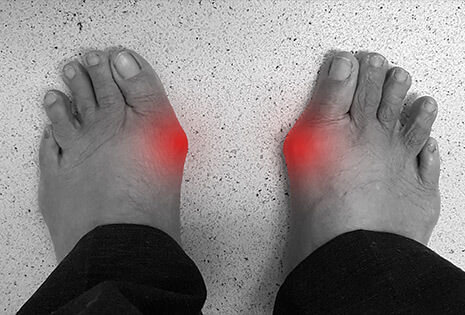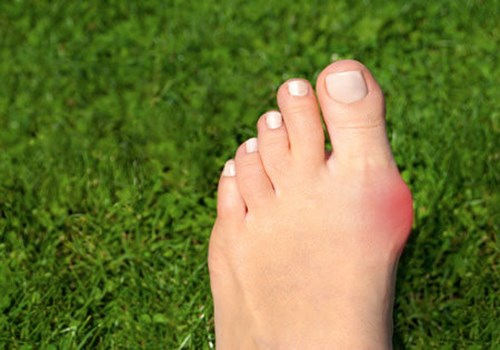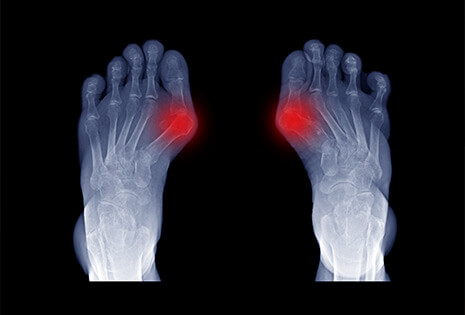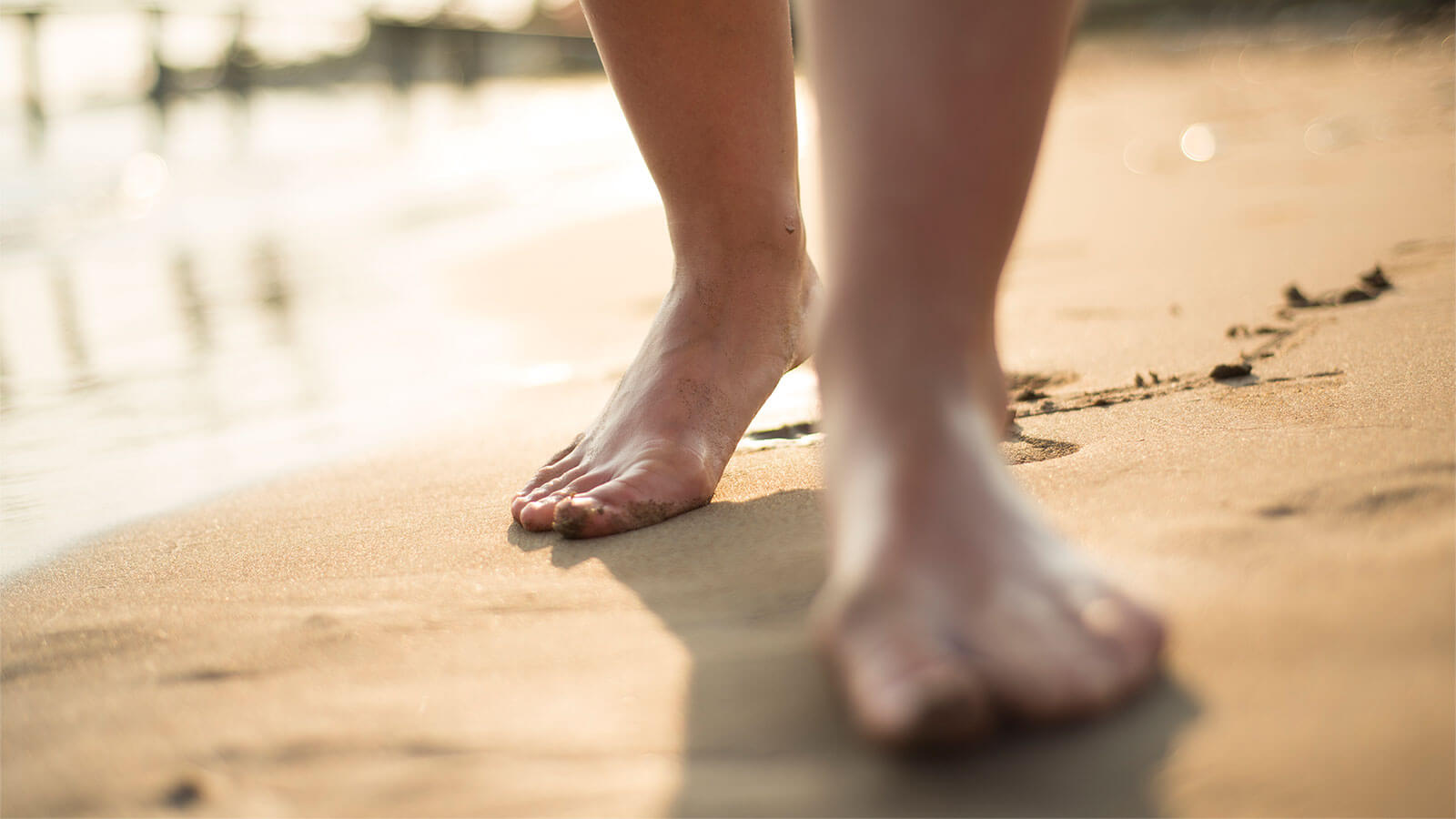April 11, 2025
Bunions usually begin with an obvious bump on the side of the big toe. This bump develops at the joint where the big toe attaches to the foot. This may cause inflammation, redness, and tenderness around the joint that may be more noticeable after long periods of walking or standing.
Most people with bunions will have some degree of stiffness or range of motion in the big toe, often with aching or burning sensations. As this happens, the big toe can begin to shift toward the second toe, increasing pressure and irritation.
In more extreme cases, painful calluses or corns can form where the toes touch each other. Knowing these symptoms is important for catching bunions early and addressing pain before it worsens.
In the sections below, we’ll take a closer look at what causes bunions, their risk factors, and treatments that are available.
Key Takeaways
-
Bunions are a common foot deformity where the big toe angles toward the second toe, causing a visible bump and potential pain or discomfort. With bunions, early recognition is key to prevent further progression.
-
Symptoms of bunions include visible toe misalignment, redness or swelling near the joint, tenderness around the bump, and difficulty finding comfortable footwear.
-
In the beginning stages, bunion pain is usually not severe and is intermittent. Over time, the pain may be persistent, restrict your activity and result in issues like calluses or corns.
-
Poorly fitted shoes, excessive time spent on their feet, family history, and other health issues can predispose individuals to bunions.
-
Untreated bunions can lead to chronic pain, arthritis, deformities in adjacent toes, and long-term mobility challenges, significantly affecting daily activities.
-
Seeking professional evaluation and timely treatment, such as proper footwear, orthotics, or in severe cases, surgery, can help manage symptoms and maintain an active lifestyle.
What Are Bunions?

Bunions are one of the most common foot conditions. They primarily impact the joint at the base of the big toe (the metatarsophalangeal joint). This deformity causes the big toe to angle inward toward the second toe.
This causes a tendency to develop a prominent bony bump on the side of the foot. Professionally known as “hallux valgus,” bunions can cause discomfort, swelling, and limited range of motion in the affected joint. Unfortunately, as time goes on, an untreated bunion will likely become worse, so early identification is key to avoiding more severe issues.
Definition of a Bunion
In short, a bunion develops because of a malalignment of the metatarsophalangeal joint. This misalignment results in a painful protrusion and can lead to anything from mild discomfort to chronic joint rigidity.
Bunions usually become red and swollen, making the toe look like a turnip. This is very appropriate because the name for bunion in fact derives from the Greek word for turnip. In advanced cases, the big toe may overlap or angle underneath the second toe.
This foot positioning limits your mobility and creates more pain.
Different Types of Bunions
Bunions come in many shapes and sizes. Adolescent bunions, or juvenile hallux valgus, affect individuals younger than 18 years of age.
At the same time, bunionettes form minor protrusions at the bottoms of the fifth toe. Bunions range from mild to severe. In mild cases, bunions produce little more than an annoying bump, but in severe bunions there is considerable deformity and pain.
Genetics and lifestyle influence these differences greatly. Along with genetic makeup, environmental influences like ill-fitting footwear and arthritis play a role, with more than 70% of cases having a hereditary link.
How Common Are Bunions?
Bunions are some of the most common foot conditions seen today, affecting about 30% of adults in the United States. Women are especially vulnerable, frequently due to shoe preferences, like high heels or pointy-toed shoes.
Internationally, bunions are a common epidemic, making education and prevention an important priority.
Early Symptoms of Bunions

Spotting the early symptoms of bunions is key to stopping their advancement. At first, symptoms can seem minor. They tend to get worse over time, causing further pain and increasing treatment needs. By identifying issues early, we can take proactive steps to prevent complications and maintain healthy feet.
1. Visible Changes in Toe Alignment
One of the earliest indicators of a bunion is the big toe shifting toward or even overlapping the second toe. This alteration typically leads to a noticeable protrusion at the big toe’s base, indicating the formation of a bunion.
Eventually this malalignment may change the foot’s anatomy, leading to a foot with a grotesque appearance. As mentioned, these changes are often very subtle and progressive, so keep an eye on the area.
2. Redness or Swelling Around the Big Toe Joint
Inflammation is another early symptom. Early diagnosis is the key to bunion treatment. Redness, swelling, and tenderness around the big toe joint are classic symptoms.
The skin can appear red, inflamed, or even discolored around this area, especially following a full day of activity or weight-bearing. Swelling usually involves a feeling of warmth, indicating inflammation of the joint.
3. Tenderness or Irritation When Wearing Shoes
For this reason, tight or narrow-toed shoes can irritate bunions, leading to pain or tenderness. Even good fitting shoes can cause irritation from rubbing or chafing.
Tenderness is typically limited to the area around the bunion, and this sensitivity can render even routine activities painful.
4. Difficulty Finding Comfortable Footwear
Bunions often render regular footwear inappropriate. Shoes such as high heels or narrow designs worsen symptoms.
Consequently, most develop a desire for wider or deeper toe box options to accommodate the condition. Making this footwear change early on can take pressure off the affected area and bring relief.
5. Minor Discomfort That Comes and Goes
Intermittent discomfort is a hallmark of early bunions. The discomfort might get worse after a long walk or run but usually goes away after a period of rest.
Allowing these easily treatable symptoms to go unaddressed can result in more chronic problems.
Advanced Symptoms of Bunions
As bunions become more advanced, the accompanying symptoms tend to become much more severe. They can severely affect your feet, mobility and quality of life. Advanced bunions frequently lead to issues that go beyond aesthetic imperfections, and it's important to treat the symptoms to prevent long-term complications.
Persistent Pain in the Big Toe Joint
Persistent pain in the big-toe joint is an advanced symptom of bunions. This pain may extend throughout the foot, which can make it hard to stand or walk, especially after extended use.
This pain not only affects the daily functions, but the quality of life by restricting movement and decreasing involvement in recreational events.
Restricted Movement in the Affected Toe
In later stages, stiffness in the hallux can limit movement of the big toe, affecting balance and gait. Eventually, the affected toe might freeze up, causing even more pain.
Swelling and destruction of the joint leads to this loss of movement. Even simple activities like walking or wearing day-to-day footwear can become impossible.
Development of Calluses or Corns
Shearing friction from improperly fitting shoes often leads to abnormal thickening of skin, such as calluses or corns that form on the top of the bunion. These changes to the skin can lead to painful symptoms.
If you ignore bunions they may cause complications such as infection or ulceration.
Impact on Walking and Daily Activities
In advanced bunions, the change in posture and walking mechanics puts additional stress on other areas of the foot. Things like being on your feet for too long, working out, or just walking around the house can be excruciating.
Pain That Worsens Over Time
Left untreated, bunions can lead to chronic pain and potentially serious issues including arthritis, pressure on nerves, or deformities including overlapping toes.
These complications highlight the need to be proactive and receive treatment early on to avoid permanent injury.
Causes and Risk Factors
Bunions are multifactorial as they develop from a combination of genetic, lifestyle, and medical factors. Persistent pressure on the big toe joint usually leads to misalignment. This forces the toe against its adjacent toe, creating the telltale bump. Understanding these impacts is essential for prevention and early intervention.
Genetic Predisposition to Bunions
Family history is the biggest risk factor for bunions. Research shows that over 70% of patients with bunions have a parent who suffered from them as well. Inherited foot structures, like flat feet or flexible ligaments, can make you more prone.
These traits can result in over-pronation, a scenario in which there’s excessive strain on the big toe joint. For instance, adolescent bunions tend to develop before reaching skeletal maturity, placing extra emphasis on the genetic connection.
Poorly Fitted Footwear Choices
Shoes that cramp, narrow or shorten the toes are major culprits of bunions. Poorly fitted footwear choices, particularly high heels, increase the risk of osteoarthritis because they put feet in unnatural positions that stress joints.
Unlike many other risk factors, this one is entirely preventable. People often don't wear supportive, well-fitted shoe choices, particularly in cities where style is prioritized.
Lifestyle Habits That Contribute to Bunions
Occupations requiring prolonged standing or walking can strain the feet, while certain sports or high-impact activities may worsen foot health. When combined with the increased pressure from weight gain, the chances of developing a bunion are even higher.
Keeping feet happy with the right balance of activity and foot care can help minimize these risks.
Medical Conditions Linked to Bunion Development
Conditions like rheumatoid arthritis inflame the toe joint, while connective tissue disorders weaken foot stability. Medical conditions that are known risk factors for bunion development include flat feet and neuromuscular disorders like Charcot-Marie-Tooth disease.
These emphasize the need to treat root health problems to preserve the shape of our feet.
Gender and Age-Related Factors
In fashion, women are more susceptible to bunions due in part to shoe styles such as high heels. While older adults are at increased risk since their ligaments weaken with age, adolescent bunions indicate a skeletal immaturity.
Hormonal and structural differences help explain these trends.
Complications from Untreated Bunions

What are the complications from untreated bunions? Complications can develop over time if bunions are not treated. These concerns go far beyond the initial pain or the bump you can see. Collectively, these complications can greatly impact foot function, mobility, and quality of life.
Chronic Pain and Inflammation
Without treatment, bunions may cause chronic pain that increases with time. This pain most commonly occurs at the joint where the big toe connects to the foot. The ongoing rubbing and strain can irritate the nearby soft tissues, causing redness, swelling, and tenderness.
In extreme circumstances, treatment of this chronic pain may necessitate more invasive measures, including corticosteroid injections or surgery. Preventative steps, such as wearing shoes with proper support or utilizing orthotic devices, can come to the rescue and prevent these symptoms from occurring.
Increased Risk of Arthritis in the Joint
Bunions speed up the breakdown of cartilage in the big toe joint area. This wear can lead to hallux rigidus—a form of arthritis characterized by stiffness and reduced joint motion. Arthritis in this area further contributes to the pain and difficulty with walking or standing.
With proper diagnosis and treatment in a timely manner, joint health can be preserved, and irreversible damage can be avoided.
Deformities in Adjacent Toes
As a bunion advances, it can force the second toe out of alignment. This eventually causes deformities such as hammer toe or claw toe, which only adds to the pain. The second toe joint can shift out of place or the toes can cross over each other.
This can cause additional pressure points, which can result in corns, calluses, or blisters. Treating bunions at their onset minimizes the risk of these secondary issues.
Difficulty Maintaining an Active Lifestyle
Bunions can make it difficult to maintain an active lifestyle. Simple everyday activities such as walking or exercising may become a challenge, taking a toll on one’s health and fitness level. Loss of movement may cause increased weight gain and other comorbidities.
This shows how important early treatment is to keep you on your feet and living an active life.
Long-Term Mobility Challenges
In the long term, untreated bunions can change one’s balance and gait, resulting in an unsteady walking pattern. In severe cases, the inability to properly walk can lead to the need for assistive devices, including a cane or walker.
These mobility issues can affect independence and daily life, but podiatric care plays a key role in preventing long-term complications.
Diagnosis and Testing for Bunions
Diagnosing bunions A complete examination is important to determine the presence of bunions and their effect on your daily life. A complete physical exam and imaging studies allow healthcare providers to differentiate bunions from other foot pathologies. They further use their extensive knowledge and experience with symptoms to provide precise diagnosis.
Physical Examination Techniques
Techniques A physical examination usually starts with a look at the shape of the foot. Doctors check for the characteristic bump at the base of the big toe and how it’s aligned. Swelling, redness, and pain around the joint are all major indicators.
During the exam, patients can expect to answer further questions about their medical history, such as the onset of symptoms and any activities that aggravate pain. This further assists in identifying potential triggers and the progression of the bunion.
Physician classification of bunion, for example as juvenile hallux valgus affects youth much differently than in adulthood.
Imaging Tests Like X-Rays
X-rays are commonly used to rule out other conditions and confirm the diagnosis. These X-ray images give a real-time view of the joint, showing the extent of misalignment and damage.
At times, imaging is used to exclude other possible causes of symptoms, like arthritis or fractures. Advanced imaging such as MRIs are rare, but can be needed if soft tissue issues are suspected.
Identifying Bunion-Related Pain vs. Other Foot Issues
Identifying Bunion-Related Pain vs Other Foot Issues Bunion pain generally focuses on the big toe joint, aggravated by narrow footwear or extensive walking. Different from other foot pain or plantar fasciitis, which is localized to the heel, bunion pain is specific.
A thorough evaluation will help you get the right treatment by focusing on the root issue.
When to Seek Professional Evaluation
If you experience persistent pain, difficulty walking, or your foot’s appearance is quickly changing, it’s time to see a professional. We know that early intervention can help avoid complications and provide better outcomes.
Non-Surgical Treatment Options
Treatment for bunions usually begins with non-surgical measures, especially in patients with mild to moderate symptoms. These approaches focus on relieving symptoms, increasing joint function, and preventing further damage to help patients better manage daily activities.
These are some of the most important strategies to relieve symptoms.
Using Padding and Orthotics for Relief
Shoe pads, bunion cushions, and orthotics provide localized support by redistributing pressure away from the bunion. These gear items help minimize rubbing and overall impact. They benefit nurses and retail workers, keeping them comfortable as they stand on their feet all day.
Toe spacers are a simple tool that work to separate the big toe from the second toe. This softening stretch alleviates congestion and friction. For even more relief, consider custom orthotics professionally designed by a podiatrist, fixing foot mechanics and realigning your feet gradually.
Medication for Pain and Inflammation
Nonsteroidal anti-inflammatory drugs (NSAIDs), such as ibuprofen, are typically suggested to relieve pain and inflammation associated with bunions. These medications usually start working within an hour, so they’re great if you need some fast relief from acute pain.
For ongoing pain, your healthcare provider may recommend an over-the-counter topical treatment or prescribe stronger alternatives.
Exercises and Physical Therapy for Symptom Management
Targeted exercises, including toe stretches and foot strengthening routines, can increase flexibility and contribute to overall foot health. Physical therapy sessions commonly involve massage, ultrasound therapy, and individualized exercise programs.
These options are particularly helpful for those looking to stay active and avoid additional joint rigidity.
Ensuring Proper Shoe Fit to Reduce Discomfort
It’s important to wear shoes with a proper fit, including a wide toe box and low heels, to minimize pressure on bunions. Footwear fit is important and experts suggest trying shoes on in the evening when feet have naturally swollen during the day.
Shoes that are tight, pointed, or high-heeled should be avoided because such shoes will aggravate symptoms.
Surgical Options for Severe Cases
As bunions advance to a more severe stage, non-surgical methods can become inadequate for lasting relief. When the deformity results in chronic pain, restricted movement, or affects activities of daily living, surgery frequently becomes inevitable.
Surgical intervention is relatively safe. You need to know what the procedure entails, what recovery will be like, and what the risks are before you make a decision.
When Surgery Becomes Necessary
Surgery is usually advised for those patients with bunions that severely impact their quality of life. Severe misalignment of the toe, chronic inflammation, or advanced arthritis often are cited as reasons.
Most individuals get surgery to get out of pain and have better functional capacity. Moreover, they aim to restore normal function, repair cosmetic deformities, and avert future complications.
Overview of Common Surgical Procedures
The choice of surgical technique depends on the severity of the patient’s condition. For instance, osteotomy, where the surgeon cuts and realigns the bone to fix the alignment.
Arthrodesis, commonly for severe arthritis or severe bunions, fuses surfaces of joints with screws or plates allowing for stability. Exostectomy—the surgical removal of the bony bump—is often performed in conjunction with osteotomy and soft-tissue repairs to restore full correction.
Surgeons can additionally reconstruct tendons or ligaments surrounding the big toe to fully maximize post-op results.
Recovery Expectations After Surgery
Recovery depends on the individual and the exact procedure but can take two to three months. Swelling can last at least six months and in some cases up to a year.
Adhering to post-operative care instructions, such as attending physical therapy and making changes to activity levels, is highly important to successful healing.
Risks and Benefits of Surgical Intervention
While bunion surgery can be very effective at alleviating pain and restoring mobility, there are risks involved, such as infection, stiffness and recurrence.
Success is strongly contingent upon the severity of the deformity as well as compliance with postoperative recovery guidelines.
Preventing Bunion Development

Preventing the development of bunions requires a multifaceted approach including footwear selection, lifestyle choices, and foot care. Attention to these areas can reduce the risk of bunion development, particularly for those with genetic predispositions or occupations requiring prolonged standing.
Choosing the Right Footwear Early On
One of the most simple yet impactful ways to prevent bunions is to wear well-fitted shoes. Footwear should provide adequate space for your feet to spread out. Look for a room of 3/8” to 1/2” between your longest toe and the end of the shoe.
Shoes that are too narrow, short, or pointy can push the toes into uncomfortable shapes. High heels more than two inches should be avoided as well to decrease extra force on the forefoot. Shoes with a “low drop” have less than 12 mm difference between heel and toe height.
Shoes like these are widely endorsed as they promote proper alignment.
Maintaining Healthy Foot Habits
Taking breaks through the day, particularly for those in labor-intensive occupations, allows time for feet to recuperate. Taking short sitting breaks every hour, even for just a minute or two, can make a world of difference.
Letting our feet air out and stretch at the end of the day increases circulation and relieves tension. Taking a picture of foot shape by tracing an outline every six months will catch early signs of change as well.
Exercises to Strengthen Foot Muscles
Simple exercises, such as toe stretches and towel scrunches, can help increase muscle strength. In addition, they improve joint stability, helping you to grasp small objects with your toes.
These easy exercises are ones you can do in the comfort of your home to improve foot strength and flexibility.
Regular Check-Ups with a Podiatrist
Plan ahead and make regular appointments with a podiatrist to catch bunions in the early stages and receive personalized prevention strategies. This is key if you have bunions in your family.
Conclusion
Bunions may begin as a minor nuisance but can turn into a major problem if left unchecked. Identifying symptoms at the earliest stage, such as inflammation or discomfort near the big toe joint, is key. Wear wider shoes and protect painful areas with bunion pads to reduce pain. Visit a podiatrist or other healthcare provider regularly to advise you on preventing further issues from developing and worsening. In extreme situations, surgery can be performed for long-term alleviation of symptoms.
How you take care of your feet can make a difference. Continued prevention efforts and treatment measures prevent bunions from negatively impacting one’s everyday life. If you’re experiencing symptoms or a bunion is forming, it’s important to consult with an experienced podiatrist as soon as possible. Some small effort today will prevent a great deal of hassle tomorrow.
Your feet take you places—wouldn’t you want to take care of them?
Frequently Asked Questions
What are the first signs of a bunion?
The earliest signs can present as a bony lump developing at the base of your big toe. Pay attention to any redness, swelling, or other pain in that area. You might see your big toe beginning to shift in the direction of your other toes.
Are bunions only caused by wearing tight shoes?
Are bunions only caused by wearing tight shoes? Although tight or ill-fitting shoes can aggravate them, that wasn’t the only cause.
Can bunions go away on their own?
Can bunions go away on their own? Or that they might not always be permanent. While bunions cannot be reversed non-surgically, making accommodations such as wearing orthotics or wider shoes can help relieve symptoms and slow progression.
How do doctors diagnose bunions?
Your doctor might order a series of X-rays to determine how severe your bunion is and what kind of changes are occurring in your joint structure.
When should I see a doctor for a bunion?
See a doctor if your bunion causes persistent pain, limits your daily activities, or doesn’t improve with home remedies like ice or shoe changes.
What are the risks of leaving a bunion untreated?
Untreated bunions can lead to chronic pain, joint stiffness, difficulty walking, or deformities in other toes due to pressure and misalignment.
Can bunions be prevented?
Can bunions be prevented by changing shoes or footwear. Keeping to a healthy weight and correcting foot problems at an early stage can further help lower your risk.
Not what you were looking for? Step Ahead Podiatry also offers the following:
Step Ahead Podiatry’s Top Resources on Foot Pain:
American Podiatric Medical Association (APMA) on Foot Health

